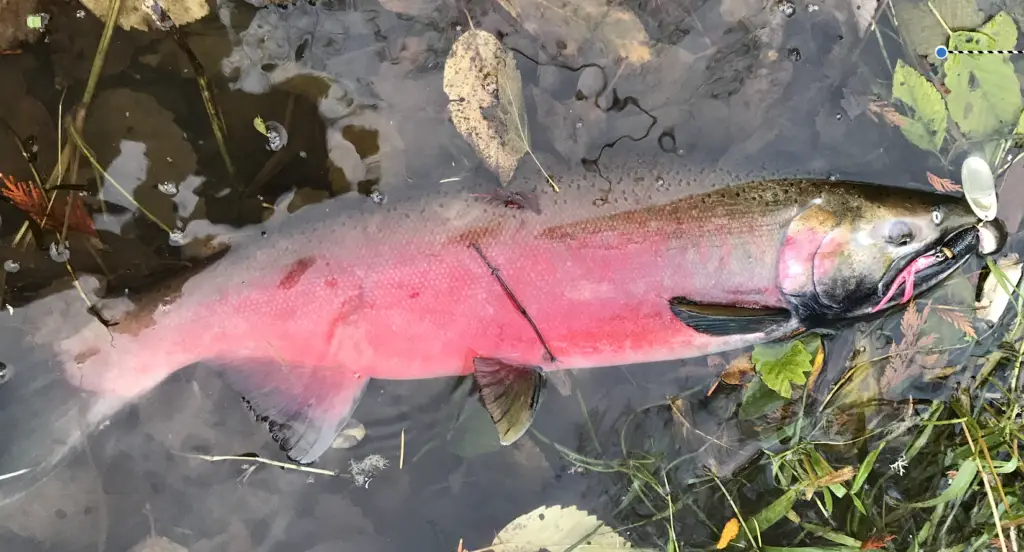
Spinner fishing for salmon is one of the most effective ways to catch several species of salmon and possibly the most fun way to feel the initial hit! The tug is THE drug! This article will clearly break down how to catch salmon with spinners.
There are two approaches to spinner fishing for salmon:
- You can use light bodied spinners like the Blue Fox Vibrax
- Or heavy-bodied spinners of the type you can buy in spinner-making kits or from a few commercial tackle-makers
Most people not having success with spinners make the mistake of fishing light-bodied spinners like heavy-bodied spinners. They toss them across the drift and reel them downstream and across too quickly for the spinners to sink and perform in a way that will attract biting salmon.
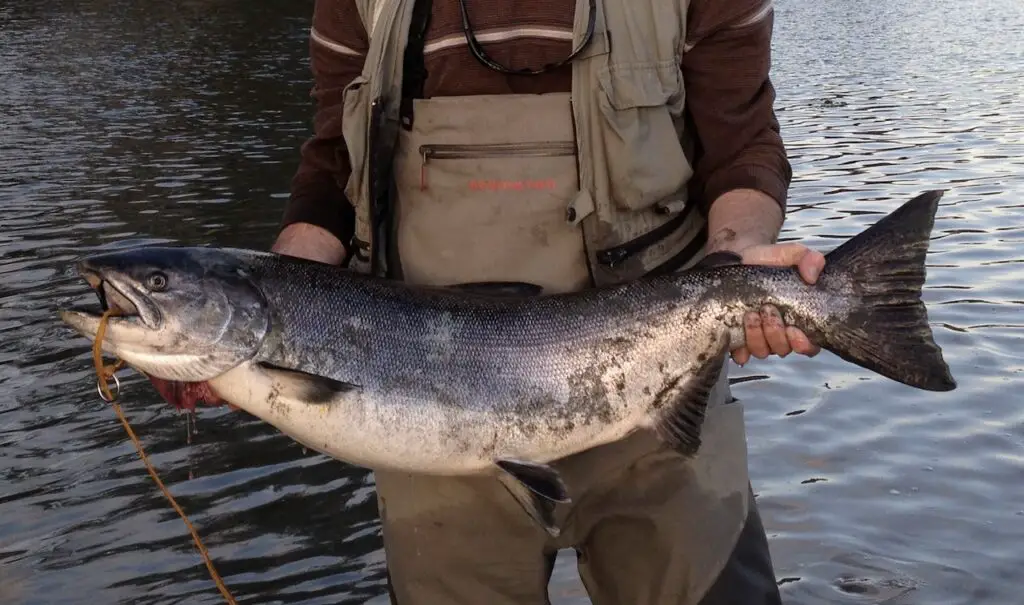
Fishing a spinner too high in the water column and too fast is exactly how not to catch salmon with spinners.
We will break down exactly how to catch salmon with spinners and we will look at each method separately, although they have some common elements as well.
Key fundamentals to catching salmon with spinners
In both methods, your goal is to move the spinner through the water with the blade spinning as SLOOOWLY as possible. How fast your spinner is moving while doing this is largely irrelevant and more a function of the water speed you are fishing.
Example: Fishing a spinner slow enough to keep the blade just spinning/pulsating in still / frog water will require the spinner to be retrieved at a faster speed.
Fishing a spinner to spin slowly through fast-moving water requires that the spinner gets retrieved much more slowly.
Keys to “perceiving” spinner blade rotation speed
In both spinner fishing for salmon methods, you need a rod that “transmits” the vibration/pulsation of the spinner blade rotating around the spinner body.
Why is this so important? Because being able to visibly see or feel the pulsations on the rod tip is exactly how you tell how fast the spinner blade is spinning.
However you need to manipulate the spinner to keep the blade moving slowly, whether reeling faster, slower, or raising and lowering the rod tip, this is your first priority. Nothing else matters.
If your rod tip stops pulsating, it could be because the spinner blade is not rotating fast enough, or you may have hit a snag. Some spinner bites are also quite soft and the rod tip no longer pulsating will be your first clue.
Many spinner bites are vicious and obvious. The tug is the drug as they say, and it will only take one of these strikes to get you absolutely addicted to spinner fishing for salmon.
Heavy-bodied spinners
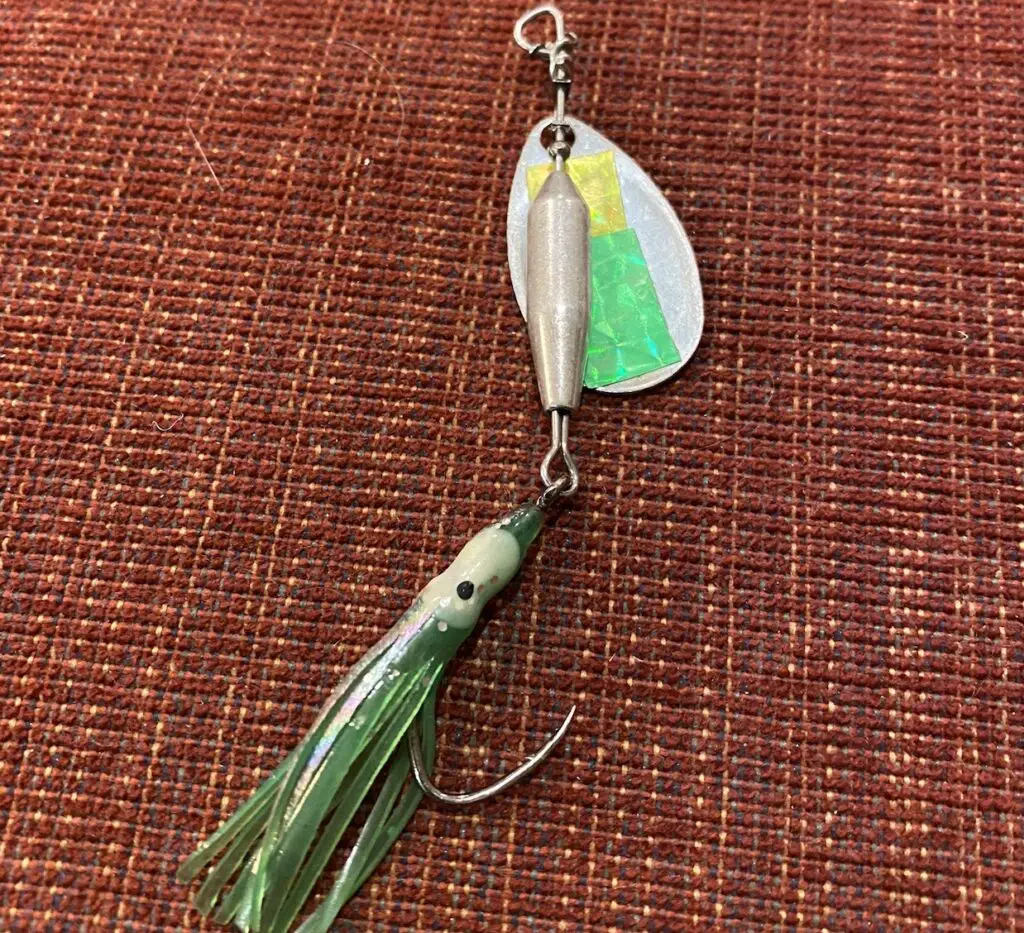
Now let’s talk about heavy-bodied spinners first.
This is the classic spinner technique that most people think of. However, almost all spinners you buy in the stores are too light to really leverage this method correctly in the fast-moving rivers of the PNW.
I buy my own spinner part kits and make my own, for two reasons:
- I need heavier spinners to properly fish with this technique
- The heavy bodied spinner technique requires fishing your spinners in a way that will result in losing some. It’s harder to do that when you spent 7$ for the spinner vs 3$.
Spinner fishing has a level of art to it, so it can be difficult to describe exactly how to perform the technique.
Each stretch of water requires slightly different techniques. Here’s how the spinner cast typically goes:
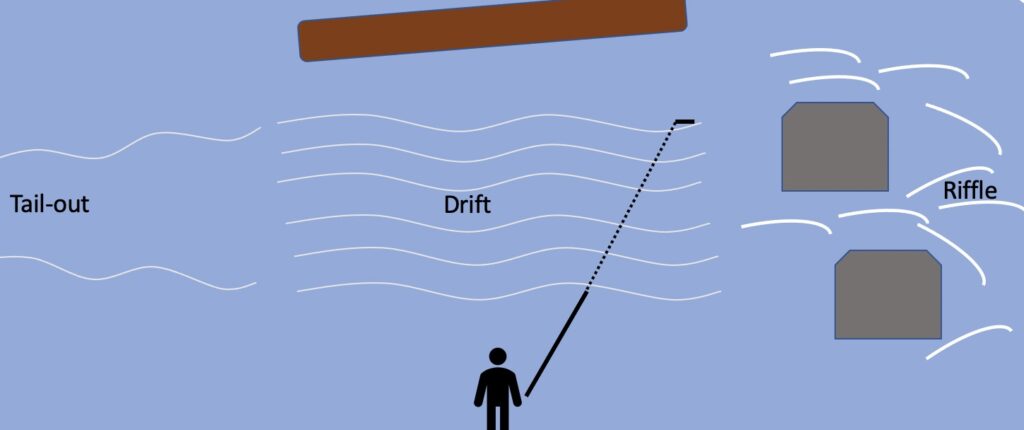
I start by casting across and slightly upstream of my position. Allowing a few seconds for the spinner to sink.
Sometimes I will start to reel immediately, very slowly to let the spinner blade spin slowly as the spinner is sinking and facing my position.
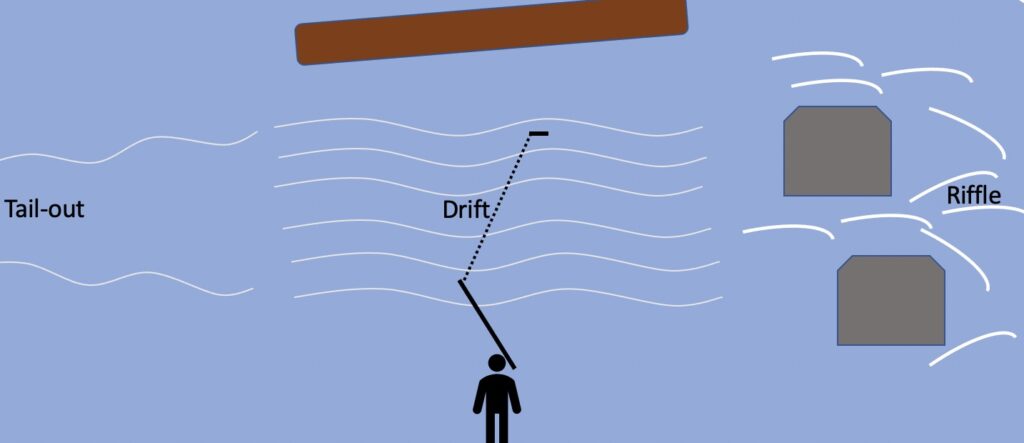
While doing this, I will keep my rod low and pointed downstream. If I were to raise my rod tip, the spinner would start to swing across too early at the top of the water column.
With the heavy bodied technique, you want the spinner to be just above bottom with blade moving very slowly as it swings through the drift.
If you don’t hit bottom at any point, you may need to adjust how far upstream you cast, reeling slower, and raising your rod tip as the swing starts which reduces the spin rate of the blade.
With this technique there is a tremendous amount of manipulation of the spinner you can do with your rod position vs relying on just reeling speed.
When executed properly in the right water, you may not have to reel hardly at all. You can do almost all manipulation with just how you hold your rod.
As the spinner swings through the drift, depending on the depth, you may need to reel slightly to keep it above the bottom, especially early on in the cast.
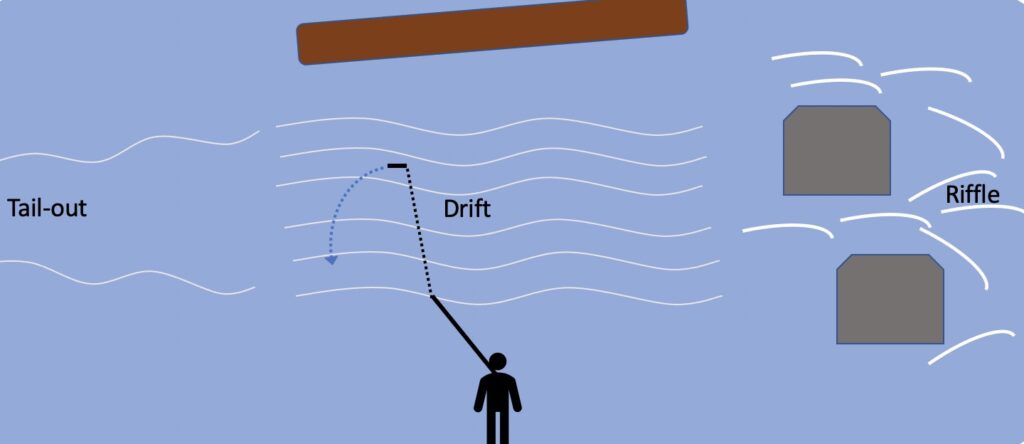
You can raise your rod to slow the spin rate and cause it to run deeper. You can also point the rod completely downstream, which will cause it to swing a bit faster, but will maintain depth while slowing the spin rate and also give it a little jitter when you first move the rod that way.
If you hold your rod straight out in front of you the spin rate will typically be at its fastest as you are creating the most tension on the spinner in the moving water.
I generally avoid this rod position until the spinner has finished or mostly finished the swing and is hanging directly below me.

In fly fishing lingo this is called the “hang down”. You want your rod either pointing straight out or completely downstream / towards the bank to cause enough tension on the spinner. Without tension, most spinners will just drop to the bottom and hang up.
Many people will give up on a cast at this point. It’s tough sometimes to remain patient, but staying with a spinner cast is critical to do, especially for coho salmon.
Keep reeling slowly, retrieving the spinner to your position. Manipulating the rod position to make the spinner look like it’s snaking its way through the water, darting one way and then the other.
Many times coho will follow all the way and bite within a few feet of your position. I’ve had steelhead take my spinner almost at my feet.
Don’t give up on the cast too early.
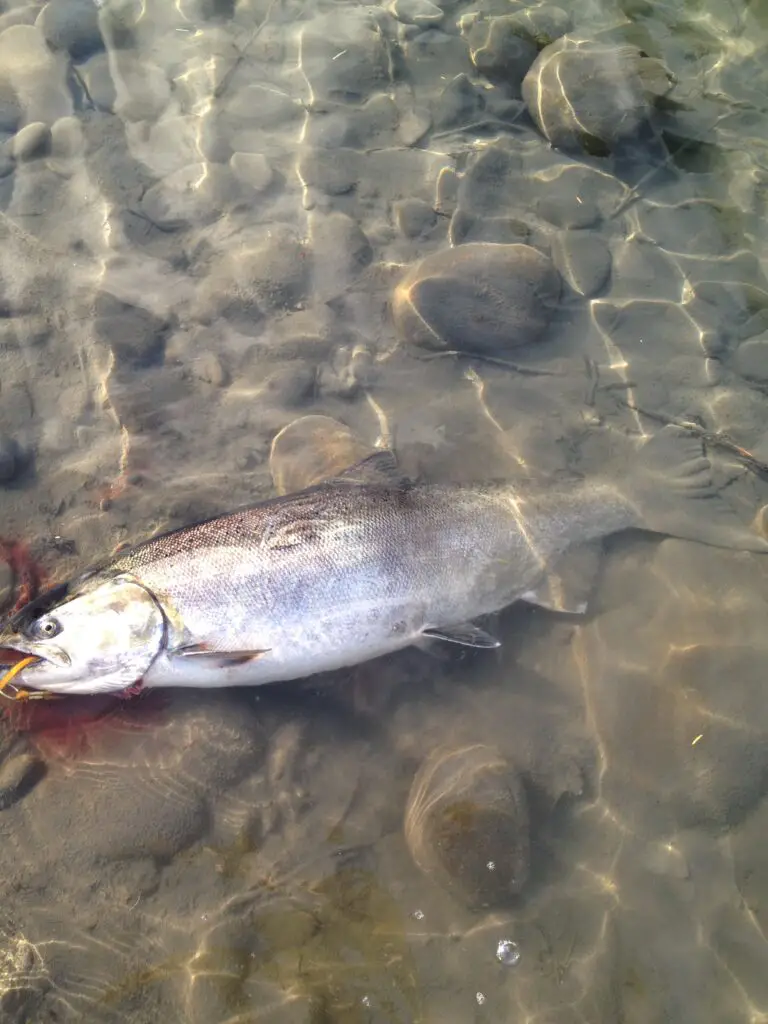
Now with kings, I’ve found that often times if they don’t bite after the swing portion of the cast, it’s not likely going to happen. Especially the big ones. They will often strike from their holding position versus chasing a lure.
A king bite on a spinner is an awesome thing though.
Light bodied spinners
Now let’s talk about light-bodied spinners. You can use light-bodied spinners with the heavy-bodied technique. In fact, that’s what most people do, but it only works in the right conditions.
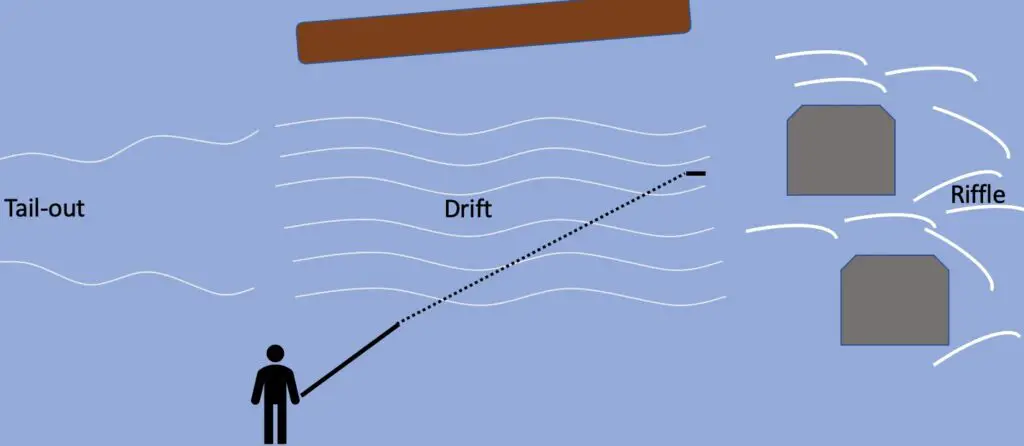
The better technique with light-bodied spinners is to actually cast upstream and reel downstream.
You may need to read the above sentence again!
That’s right. You cast way upstream and begin to reel almost immediately, depending on the depth of the water.
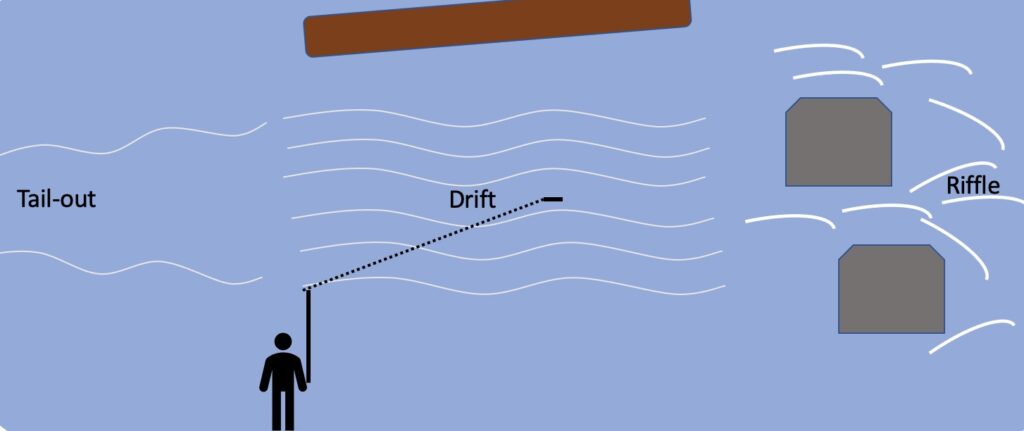
Just like with the heavy-bodied spinner technique you want to keep the blade spinning as slow as possible while having it still spin/pulsate.
If you do it right, the light-bodied spinner will stay right around the mid to lower water column as it is retrieved to your position.
This technique is particularly good for coho, who don’t need a spinner put right in front of their faces to strike and will come up to hit it.
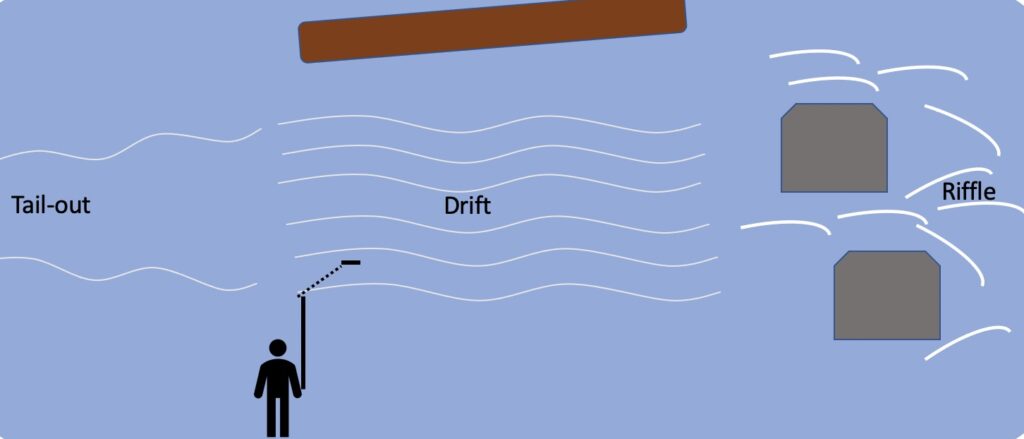
The light-bodied technique takes some of the “art” out of fishing the spinner slow enough, as the spinner being cast upstream and facing downstream reduces a lot of the current drag that would increase the spin rate.
The spinner does travel faster through the water due to the reeling speed + the current speed both taking the spinner downstream.
Again, it’s more important that spinner spins slow vs moving slow through the water.
You can also get away with using a larger profile light-bodied spinner as the larger spinner won’t disrupt your technique the way a large heavy-bodied spinner may sink too quickly.
You can also move your rod position to point upstream, which will put more tension on the spinner and slow its speed through the drift.
You can point it downstream, and the spinner will move faster through the drift and won’t swing as quickly.
It’s typically good to use a neutral rod position, pointed at the river (12 o’clock), reeling slowly the entire time.
You can also combine the techniques. You can start with an upstream cast, reeling towards you and as it approaches your position, point the rod more upstream, to cause it to start swinging through the drift as it passes your position, and now you have a downstream/heavy-bodied technique in action.
All of these techniques are useful in different situations depending on the water.
Putting it all together to fish for salmon with spinners
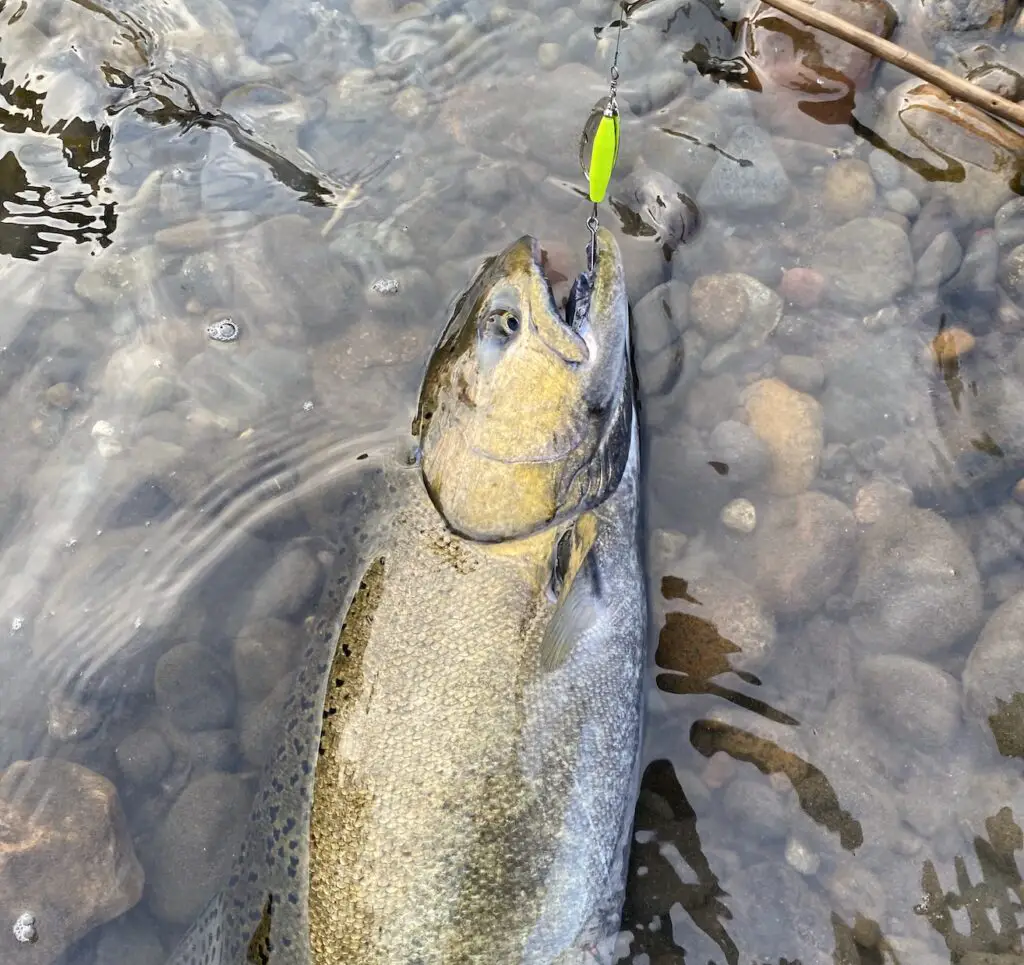
Now that we’ve discussed the techniques, let’s talk about actually fishing spinners for salmon.
There are some situations, usually with coho or pinks, when you can make the same cast over and over again and keep catching fish. These are the exception, not the rule. In most scenarios, using spinners is meant to be a moving technique.
The goal is to cover water.
When drift fishing or float fishing, you might pound the same stretch of water, adjusting inch-by-inch to dial in the presentation.
Spinner fishing is not like that typically. In a 100 ft stretch of water, there might be one spinner fish.
That is one salmon who’s so trigger-happy, that when your spinner is properly presented within 10 ft of that salmon’s position, it’s going to attack, seek and destroy.
And leave you shaking with adrenaline!
What that means, is you should rarely ever make the same spinner cast twice. I like to cast, move a few feet downstream, and then cast again. I’m seeking that spinner fish.
Sometimes, it could take 100 feet to find it, but you often times will.
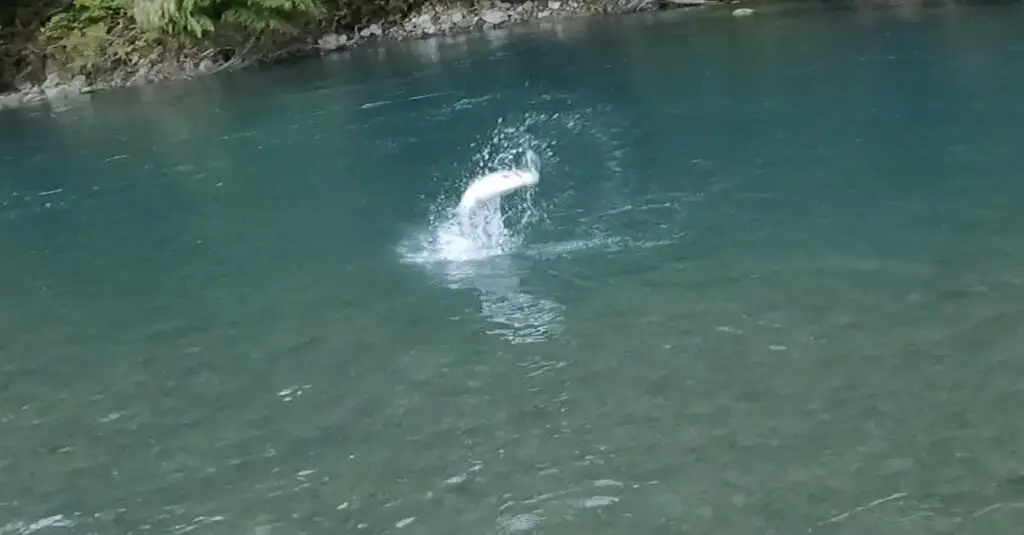
This means that when it comes to spinner fishing, you need to be more selective about where you are willing to employ the technique.
If you are going to travel a few hours to the coast to fish a 50 ft stretch of bank…I would bring more than just a spinner plan to that fishing trip.
Now, if you are searching for salmon over a mile of bank fishing opportunity…that could be a perfect setup to connect with multiple salmon.
What I will often do is bring both a spinner fishing setup and another setup like float fishing. I can pound the water with float fishing, and then run it through with a spinner to find that one fish.
Sometimes, running a spinner through the water I’m float fishing without success, will actually turn on a float fishing bite.
I don’t start with the spinner though because if the salmon are spooky, I don’t want to throw them off. Sometimes salmon will take a float presentation over and over again if targeted in a stealthy way.
More on float fishing for salmon here.
Spinner blade rotational speed to attract salmon
Let’s talk about why it’s so important to move the spinner blade slowly. The best analogy I’ve heard is to compare it to a sign on the side of a building. What catches your attention more? The sign that is blinking or the fixed light sign?
The blinking sign right? Exactly.
When a spinner blade is moving too quickly, it’s like the fixed light sign. When a spinner is pulsating slowly, it’s more like the blinky sign, pulsating intermittent flashes of color or light versus a steady stream.
How can you tell how fast your spinner blade is turning? Watch your rod tip.
If you cannot see each turn of your spinner on your rod tip, you are using the wrong rod or too small of a spinner for that rod.
I have a variety of rods I use depending on the species I’m targeting and the spinner size I’m fishing.
Smaller spinners require a more sensitive rod (or faster action tip) to be able to see the pulsation and larger spinners can’t transmit blade rotation to a stiffer rod.
Spinner selection
This conversation naturally takes us to spinner selection.
Now we are in deep waters…There are many more guidelines than hard and fast rules here. There are also a lot of myths. You don’t need a big spinner to catch a big fish, and using a small stealthy spinner is not always the best way to fish small water.
And presentation, the techniques discussed earlier matter more than any color factors in selecting spinners.
A properly presented “wrong spinner” will always out fish the “right spinner” being wrongly presented.
Here are a few things which do matter:
Water temperature and flow rate – This might the most important one. When I was fishing almost exclusively with spinners, I would take the water temperature (use something like this ) of a new river or after a big weather change.
Lower temps require bigger spinners and brighter colors to get the attention of salmon. There’s something called the attraction threshold.
You want to choose the spinner with the highest attraction threshold, that won’t repel fish.
Using a size 5 spinner in 60 degree clear water on a sunny day, might not be a great choice.
In the same way, using a size 2 in 35-degree water could be improved upon significantly without spooking fish.
The guideline is to use larger flashier spinners in colder water, and to use smaller spinners with duller colors in higher temperature waters.
This also somewhat assumes the water flow matches these temps. Higher temp waters such as during Aug / Sep, usually also accompany lower flows.
For summer steelhead in those months, I like to use black / brass/copper spinner sizes 2-3.
Colder water may warrant larger / flashier spinners regardless of flow rate, whereas higher temps require smaller spinners in smaller water.
However, you can fish big spinners in August to catch kings in the Columbia when the water is 60-70 degrees for example.
During the fall, as temps cool down and flow increases, you can increasingly do better with size 4, 5, and 6 spinners with big hoochies on the hooks, etc.
Light conditions – Midday sun might require darker color choices in spinners vs dawn or overcast conditions can get away with silver/gold. This of course is also influenced based on water clarity and temperatures.
Species of salmon – I’ve caught most of my salmon on basically two color combinations of hard-bodied spinners. I will also provide the links to the blue fox spinners I like to use. Lots of spinner colors and combinations work, but I like to start with basic metal finishes that have colors augmenting these finishes.
Here are my two combinations:
- Silver body, silver blade size 3 –4, green/chartreuse coloring inside the blade, green tubing/hoochie on the hook
- Silver body, silver or brass blade size 2 -3, pink inside or outside the blade, pink hoochie on the hook.
I use size 4 – 6 blue fox light-bodied spinners with black bodies, silver blades tipped orange or chartreuse, and pink hoochies.
Rigging up for spinner fishing for salmon
I love using braided lines for fishing spinners for salmon. I used to do the mono thing, but the problem here is that I lost a lot of gear as even higher diameter mono like a 12-15 lb test would break too easily.
With braid I can use a 20 lb test which has a very small line diameter, which allows me to pull my spinners free of snags without breaking it off most of the time. One of the challenges with braid though is that about 1 of every 3 casts will result in the braid tangling around the spinner shaft.
The solution here is to attach a fluorocarbon top shot of line directly to the braid using an FG knot. This knot is extremely strong, and basically the same profile as the line itself.
Here are a few of the rods I prefer to use with my spinners.
This Okuma 9’9 spinning rod will fish many sizes of spinners effectively from size 3 to size 6. You will need to factor drag settings on your reel to match hook/spinner sizes to avoid losing a lot of fish though.
What do I mean here? King/chinook salmon have very tough bony mouths.
If you have a lighter drag setting, there’s no way you will get a big hook on a size 6 spinner to penetrate and you will likely lose that salmon in the first few seconds unless the drag is set really tight on the initial hook-up.
This is where a beefier rod will help drive that tine or hook point in as well.
This Okuma 9’0 Medium rod is more ideal if you know you are casting spinners for chinook. A little stronger backbone will help punch that hook in, while still having a faster action taper will help transmit spinner vibration back to the angler.
Now, if you hook a bright feisty coho with that big spinner, barbless hook, tight drag…I would bet money that 9 out of 10 times, you are going to lose that salmon.
In fact, I’ve experienced this many times. I was on a guided fishing trip on the Humptulips once where the guide was like “Don’t touch my drag settings!”.
Of course, they were all setup for kings and I remember hooking 6-7 coho in a row and losing every single one of them.
Want to catch 9 out 10 coho you hook? Use something like this Okuma 9’6 Light spinning rod.
In the link above, you may have to still select the CE-S-962la rod model. But anything that is a 4-8 lb line rating and 9’6 length tends to be constructed with lots of give that allows you to not lose connection with a spastic fresh coho.
Now, keep in mind the above rod is ideal for your typical 4-10 lb variety of coho…and you can land many big fish on a rod like that if you know how to fight a salmon properly. Connect with a much bigger coho or bigger king and you will have some challenges (fun?!).
Another approach after hooking a salmon on a tighter drag setting is to back it off to allow the fish to have just enough wiggle room to keep it on the barbless hook.
For the spinners themselves, with the barbless hook requirements I like to use the open-eye sickle hooks. Replace the standard j-hooks that come with many spinners with these sickle open-eye hooks. Match the hook size to the spinner.
What type of type of water to fish spinners for salmon in
Spinner water can be a wide variety of water types. Here are a few classic water types and a rough strategy to fish them.
The classic drift – This water gets gradually deeper the further you wade into the river from a classic gravel bar position.
Typically, this classic drift water will be walking speed or slightly faster. This is the easiest water to fish for both heavy and light-bodied spinners.
With a heavy-bodied spinner, you can cast directly across the drift or slightly upstream and work the spinner slowly through the drift until the hang-down position at which point you can gradually work it back until it’s at your feet.
Don’t neglect the water right in front of you either.
With a light-bodied spinner, you can cast way upstream and reel slowly all the way back to your position.
The seam – This water is like the classic drift except that the water gets dramatically faster and deeper the further away from your casting position.
You want to fish the transition point between the slow and the fast water with your spinner.
With a heavy bodied spinner, I will cast slightly further upstream into the fast water to give the spinner a chance to sink as it comes towards you.
You want to retrieve your slack such that the spinner blade begins to spin/pulse right as you pull the spinner into the seam from the fast to slow water.
You want the spinner to start to work across the drift from this point. If you just cast into the seam directly, you can miss the best water right at the transition point.
With a light-bodied spinner cast way upstream into the seam directly, it won’t be pulled towards you as dramatically as a downstream approach and reel fast enough to get the blade moving.
The deep pool – Treat this just like the classic drift approach, but cast further upstream to allow the spinner to sink for several seconds before you start reeling.
A heavy-bodied spinner is going to work much better here as it will sink faster.
The frog water – I like to fish frog water with light-bodied spinners. With no current, you can get a lighter spinner to sink easily.
Just cast into the frog water, wait several seconds, and start reeling slowly, with just enough speed to keep the blade spinning. Deadly.
The classic tail out – Treat this like the classic drift with the one variation being you will have to raise and lower your rod tip as well as reel faster in different sections.
Tailouts can be much more shallow and have large rocks or other materials, you may need to lift a spinner above, before allowing it to sink again.
This is also a technique better suited for the heavy-bodied spinner working down and across.
Lastly in conclusion
While this article attempted to cover everything, you should also read all about river fishing for salmon.
And perhaps buy a book or two about the topic of spinner fishing for salmon. Here are two good ones I recommend:
- Spinner Magic by Jim Bedford
- Spinner fishing for Steelhead, Salmon and Trout by Jed Davis – This is the absolute spinner fishing bible and a must read for anyone serious about this salmon fishing technique.